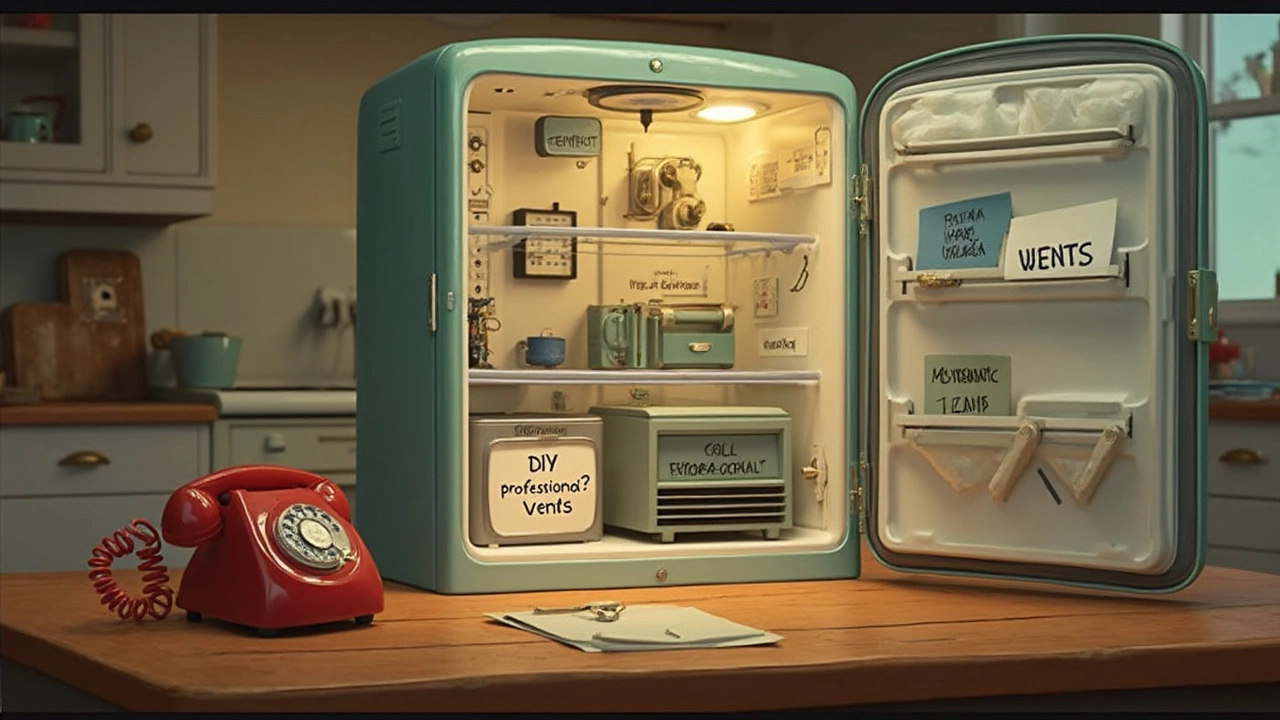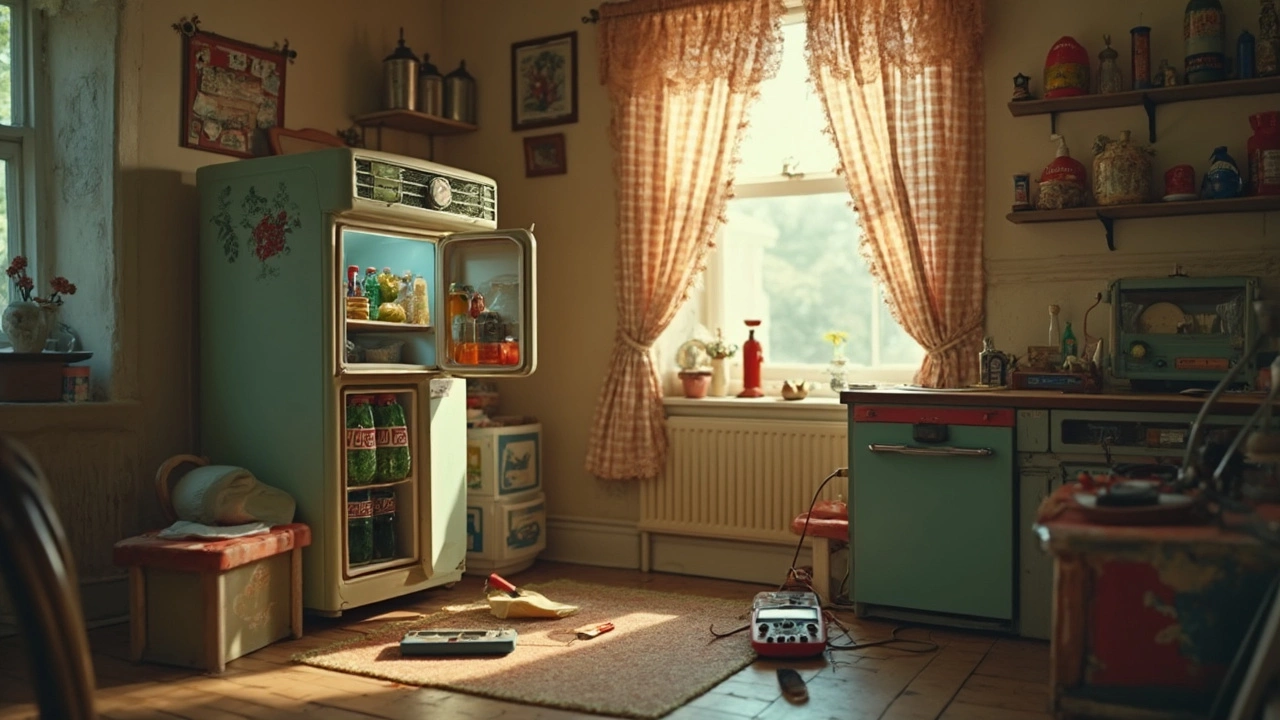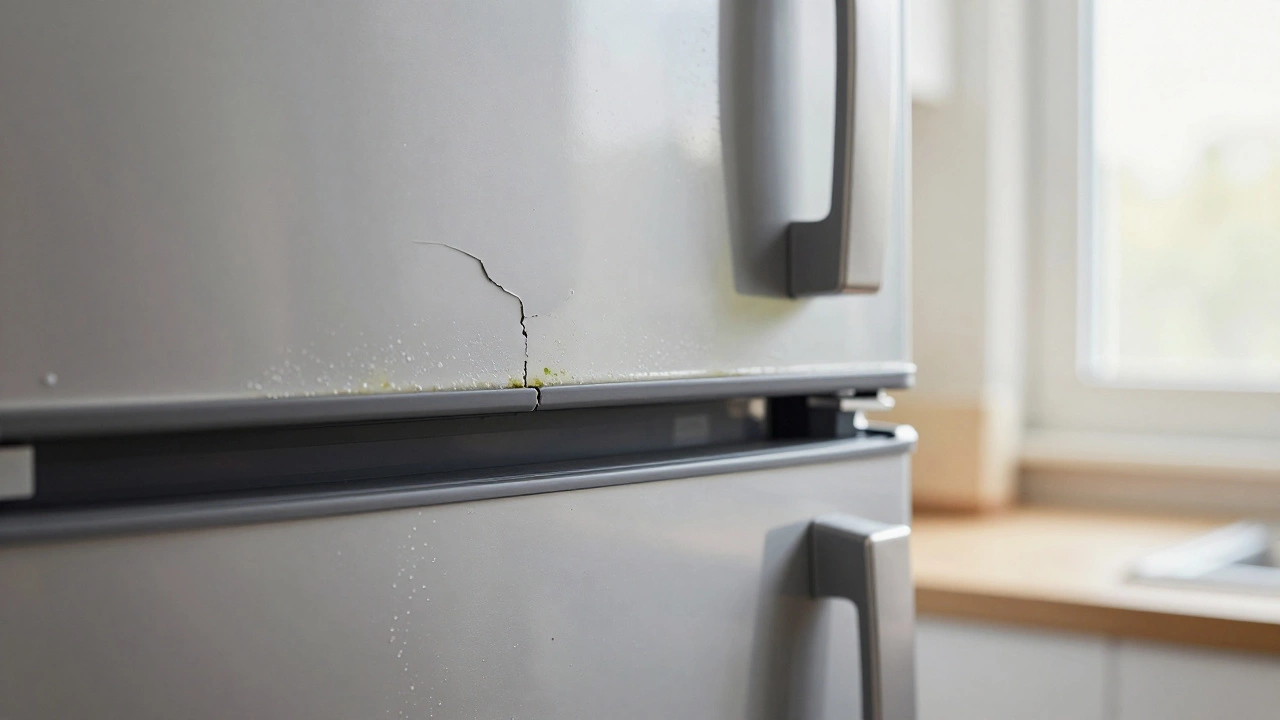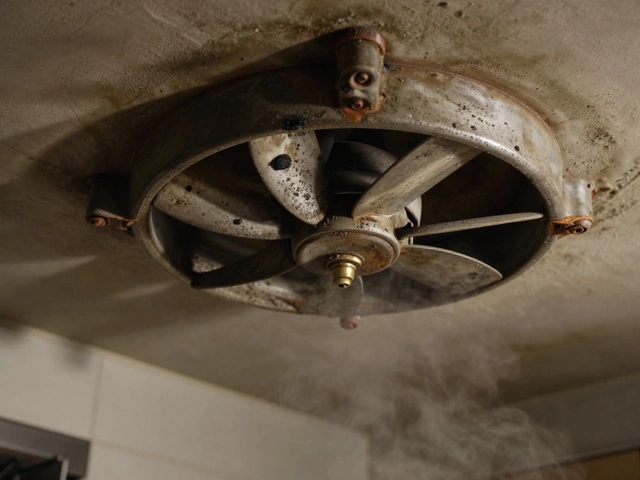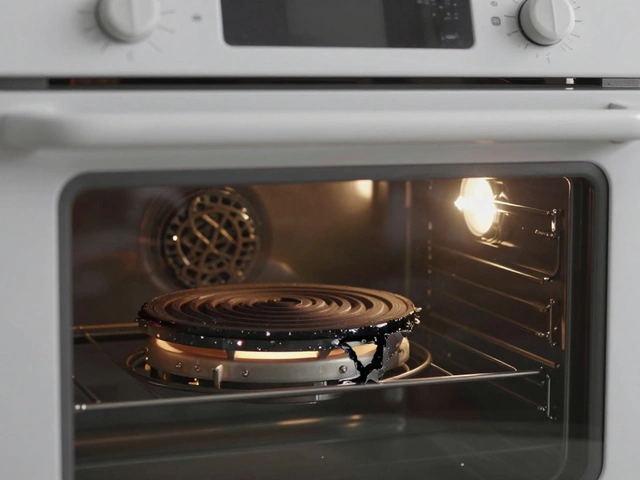So, your fridge suddenly isn't cooling, but the light is still on. It's super annoying! Before you start freaking out about all the groceries sitting inside, let's figure out what's going on. One of the first suspects in this mystery could be a blocked vent. If air can't circulate properly because of ice build-up or a misplaced item blocking the vent, cooling can suffer. It's an easy first check without breaking a sweat.
If vent blockage isn't the issue, the often over-looked evaporator fan might be the culprit. If it's not spinning, airflow inside the fridge stalls, leaving it warmer than you'd like. You'll usually find this fan in the freezer section, so a quick listen for a running fan sound when the door is open can give you some clues.
Another part you want to examine is the thermostat. Sometimes it might be set wrong or simply malfunctioning. Make sure it's at the recommended level, usually around 37°F. If you adjust it and nothing changes after a few hours, it might be on the fritz. At this point, it could be time for a bit of professional help if you're not into tinkering with appliance parts.
- Common Causes for Cooling Issues
- Checking the Evaporator Fan
- Ensuring Proper Airflow
- Examining the Thermostat
- Knowing When to Call a Pro
Common Causes for Cooling Issues
First things first, when your fridge not cooling is the problem, there are a few usual suspects to look into. Let's break it down into bite-sized bits.
1. Blocked Vents
Your fridge needs good airflow to keep things chill. If the vents are blocked, even by something as simple as an over-stuffed fridge or some chunky ice accumulation, it's bad news. Make sure everything's clear and the items inside are not pushed against the vents.
2. Faulty Evaporator Fan
The evaporator fan plays a big role in cooling. If it's not working right, your fridge won't circulate cold air as it should. Here's a quick check: open your freezer door and listen for the fan. No buzz, no hum? That could be your issue.
3. Thermostat Problems
The thermostat's role is crucial—it tells your fridge when to cool up. If it's playing tricks, your fridge could think it's cooler than it is. Check it, make sure it's set around 37°F for the fridge and 0°F for the freezer. Adjust if needed and wait—a little patience here can go a long way!
4. Dirty Condenser Coils
The condenser coils are usually at the back or on the bottom of your fridge, covered in dust bunnies. When they’re dirty, they don't work optimally, leading to cooling issues. Dust those coils off! It's an easy task that can save a lot of headaches.
| Issue | Possible Solution |
|---|---|
| Blocked Vent | Rearrange items to clear the vent |
| Fan Not Working | Listen for sounds or check if the fan is spinning |
| Thermostat Setting | Adjust thermostat to recommended settings |
| Dirty Coils | Clean the coils every 6 months |
5. Door Seal Trouble
That's right—sometimes the issue could be as simple as the door seal not closing properly. This lets warm air in. Check the seal for cracks or bits of food stuck and replace it if it's damaged.
Keep these top contenders in mind, and you'll have a good start on tackling your cooling issues. It might save you the hassle and cost of calling someone in!
Checking the Evaporator Fan
Alright, so let’s delve into the world of evaporator fans. You’ve probably never noticed this humble component, but it’s crucial for keeping your fridge cooling efficiently. When it's not working, your fridge might not cool properly even though the light is on.
The evaporator fan is usually located in the freezer compartment and is tasked with circulating cold air through both the freezer and the refrigerator. When it fails, you will often notice a distinct lack of chilly air reaching the main compartment.
How to Check If the Evaporator Fan Is Functioning
- First, open the freezer door and listen carefully. If you don’t hear the fan running, it's a red flag.
- Next, ensure the fridge is plugged in and the light comes on when you open the door. If all's well with the power, you likely have a fan issue.
- You'll need to remove the inside panel of the freezer to get to the fan. Unscrewing the panel usually does the trick, but always check your specific model’s manual.
- Once exposed, check to see if anything is obstructing the fan blades. Ice or food debris can block it.
- If the fan looks clear but still won't spin, use a multimeter to check for continuity. No continuity means it’s likely kicked the bucket.
"The evaporator fan motor is a key component that can lead to cooling issues if not functioning," says Mike Ingersoll, a technician with 20 years of experience in appliance repairs.
Replacing the Evaporator Fan
If your fan checks out with no continuity or visible issues, it's time for a replacement. You can pick up a suitable replacement at most appliance stores or order one online. Make sure it matches your fridge model exactly.
- Unplug your fridge before starting any repair work – safety first!
- Unscrew the old fan and carefully disconnect it from any wiring.
- Reconnect the new fan following the reverse steps and secure it back with screws.
- Power everything back up and listen. Does the new fan spin? If yes, problem solved.
A functioning evaporator fan should set your refrigerator back on its cooling course. And hey, if this all seems a bit over your head, no shame in calling in a pro—sometimes they can save you time and effort when things get tricky.

Ensuring Proper Airflow
When it comes to making sure your fridge isn't turning into a tropical zone, airflow is key. To start, keep in mind that your fridge needs some breathing room. That means you gotta watch how you’re stacking your food. Overstuffing blocks airflow, which means your fridge not cooling might just be a simple overcrowding issue.
Keep It Organized
When organizing, leave some space between items. This lets cool air circulate better, and your fridge doesn’t have to work overtime trying to maintain its cool. If you're stacking smaller containers, try to keep them towards the center, allowing vents and circulation areas on the side to stay clear.
Check Vents
The next bit is about knowing where your fridge vents are. You might find them near the back wall or along shelves. Make sure nothing is directly blocking these vents, like that large tub of leftover soup you’re saving for later. Take a look and rearrange as needed for proper air passage.
Clean Those Coils
Sometimes the airflow issue starts outside your fridge, specifically behind it. Dirty condenser coils can mess with how well your fridge cools. Every few months, pull the fridge out and clean the coils using a vacuum or coil cleaning brush.
| Temperature Zone | Optimal Temperature | Tip |
|---|---|---|
| Fridge | 37°F (3°C) | Ensure consistent airflow |
| Freezer | 0°F (-18°C) | Avoid overstocking |
Now, if you’ve tried all these tips and your refrigerator light on problem persists without cooling, it might be time to dig deeper into mechanical issues, but at least with airflow optimized, you'll know it’s not a simple fix.
Examining the Thermostat
Alright, let's get hands-on with your fridge's thermostat. If your fridge isn't cooling but the light's still blazing, this is a part you'll want to scrutinize closely. The thermostat's job is to keep things chill inside, literally. But when it's not working, all bets are off!
Double-Checking the Thermostat Setting
First things first, let's ensure that someone didn't accidentally crank it to a weird setting. Open the fridge and locate the thermostat dial. It's usually sitting pretty somewhere on the fridge's interior wall. For the ideal temp, aim for about 37°F for the fridge and 0°F for the freezer.
If tweaking the dial doesn't do the trick after a few hours, we might have a bigger issue at play. Make sure the dial is responding—some older fridges might have dials that don't work properly anymore.
Testing the Thermostat
If things still aren't cool enough inside, consider giving the thermostat a little test. Basically, you want to see if it's sending the right signals to start cooling. You'll need a multimeter for this, to check the continuity. Be sure to unplug the fridge first—you don't want a shocking surprise!
Remove the thermostat, which often just means pulling off the panel, unscrewing it, and disconnecting the wires. Set your multimeter to measure ohms and check for continuity. If there's none, you know what's not pulling its weight.
When Is Replacement Necessary?
Finding no continuity usually means it's time for a new thermostat. They aren't too pricey, but if you're not comfortable with doing this yourself, that might be a sign to get a professional onto it. After all, they're pretty crucial for keeping your refrigerator light on and things inside super cool.
While fiddling with wires isn't everyone's gig, it's a good skill when your trusty appliance isn't doing its job. Plus, fixing it yourself can save you some cash, compared to having a technician visit.
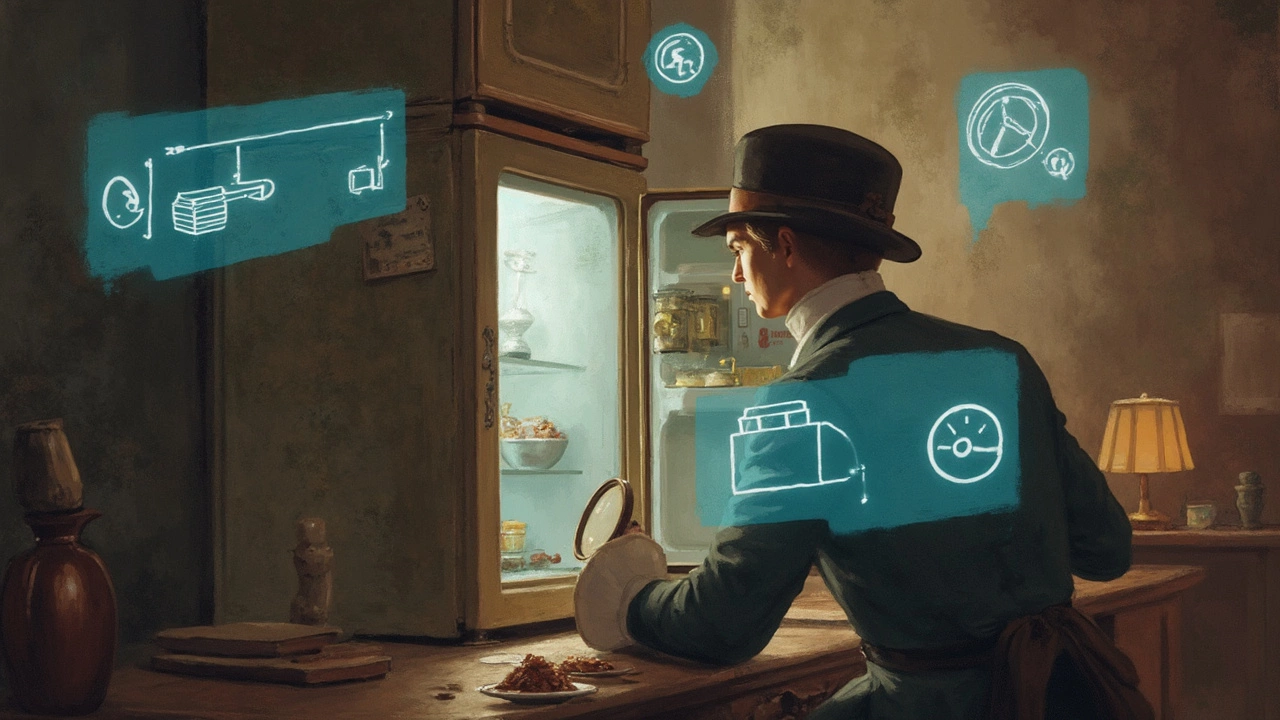
Knowing When to Call a Pro
Alright, sometimes DIY solutions aren't enough, and it's perfectly okay to tag in a professional when needed. But how do you know when to make that call?
Signs It's Time for Professional Help
Here’s a little checklist to guide you through:
- Your fridge not cooling persists despite checking the obvious problems like vents, the evaporator fan, and the thermostat.
- You hear strange noises, like banging or clunking, coming from the compressor or motor area.
- There's a sudden spike in your electricity bill, suggesting your fridge is working overtime to compensate for a cooling issue.
- You've tried resetting the refrigerator settings, and the cooling issues still hang around like a bad smell.
Why Call a Pro?
Professional technicians not only have the tools but the know-how to safely handle refrigerant, fix compressor problems, and even replace complicated components. Let's face it, some repairs are just too risky or complex for the average person. And hey, sometimes, calling in an expert can save you money and hassle in the long run because they can pinpoint issues you might miss. A pro could make the difference in whether you’re back to chilling rather than grilling (your nerves, that is)!
Vital Stats to Keep in Mind
If your fridge is more than 10 years old, you might want to weigh repair costs against a replacement, as newer models are often more energy-efficient. Check out this stat for context:
| Fridge Age | Efficiency Improvement Compared to 10 Years Ago |
|---|---|
| 5-10 Years | 10-20% More Efficient |
| 10+ Years | 20-40% More Efficient |
Ultimately, knowing when to call a pro helps keep your cool—and your groceries safe—from disaster. A little expert assistance might just get your refrigerator back on track quickly and efficiently.
